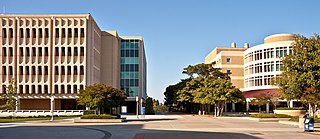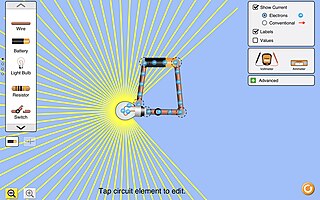Related Research Articles

Ground-level ozone (O3), also known as surface-level ozone and tropospheric ozone, is a trace gas in the troposphere (the lowest level of the Earth's atmosphere), with an average concentration of 20–30 parts per billion by volume (ppbv), with close to 100 ppbv in polluted areas. Ozone is also an important constituent of the stratosphere, where the ozone layer (2 to 8 parts per million ozone) exists which is located between 10 and 50 kilometers above the Earth's surface. The troposphere extends from the ground up to a variable height of approximately 14 kilometers above sea level. Ozone is least concentrated in the ground layer (or planetary boundary layer) of the troposphere. Ground-level or tropospheric ozone is created by chemical reactions between NOx gases (oxides of nitrogen produced by combustion) and volatile organic compounds (VOCs). The combination of these chemicals in the presence of sunlight form ozone. Its concentration increases as height above sea level increases, with a maximum concentration at the tropopause. About 90% of total ozone in the atmosphere is in the stratosphere, and 10% is in the troposphere. Although tropospheric ozone is less concentrated than stratospheric ozone, it is of concern because of its health effects. Ozone in the troposphere is considered a greenhouse gas, and as such contribute to global warming. as reported in IPCC reports. Actually, tropospheric ozone is considered the third most important greenhouse gas after CO2 and CH4, as indicated by estimates of its radiative forcing.

Carl Edwin Wieman is an American physicist and educationist at Stanford University, and currently the A. D. White Professor at Large at Cornell University. In 1995, while at the University of Colorado Boulder, he and Eric Allin Cornell produced the first true Bose–Einstein condensate (BEC) and, in 2001, they and Wolfgang Ketterle were awarded the Nobel Prize in Physics. Wieman currently holds a joint appointment as Professor of Physics and Professor in the Stanford Graduate School of Education, as well as the DRC Professor in the Stanford University School of Engineering. In 2020, Wieman was awarded the Yidan Prize in Education Research for "his contribution in developing new techniques and tools in STEM education".

Susan Solomon is an American atmospheric chemist, working for most of her career at the National Oceanic and Atmospheric Administration (NOAA). In 2011, Solomon joined the faculty at the Massachusetts Institute of Technology, where she serves as the Ellen Swallow Richards Professor of Atmospheric Chemistry & Climate Science. Solomon, with her colleagues, was the first to propose the chlorofluorocarbon free radical reaction mechanism that is the cause of the Antarctic ozone hole. Her most recent book, Solvable: how we healed the earth, and how we can do it again (2024) focuses on solutions to current problems, as do books by data scientist Hannah Ritchie, marine biologist, Ayana Elizabeth Johnson and climate scientist Katharine Hayhoe.

The School of Physical Sciences is an academic unit of the University of California, Irvine (UCI) that conducts academic research and teaching in the field of physical sciences. It offers both pre-professional training and general education in the departments of chemistry, earth system science, mathematics, and physics and astronomy. The school enrolls 1,400 undergraduate and graduate students and is one of the top schools in the nation in the number of degrees it confers in the area of physical sciences. It also offers specializations such as biochemistry, statistics, math for economics, applied and computational mathematics, astrophysics, applied physics, biomedical physics, and education. In 1995, the school gained international prominence when Frank Sherwood Rowland, a professor in chemistry and Frederick Reines, a professor in physics, won the Nobel Prize in their respective fields. It was the first time two people won the prize in the same year in two different fields at the same public university.

PhET Interactive Simulations, a project at the University of Colorado Boulder, is a non-profit open educational resource project that creates and hosts explorable explanations. It was founded in 2002 by Nobel Laureate Carl Wieman. PhET began with Wieman's vision to improve the way science is taught and learned. Their stated mission is "To advance science and math literacy and education worldwide through free interactive simulations."
Veronica Vaida is a Romanian-Hungarian-American chemist and professor at the University of Colorado Boulder. She is an expert in environmental chemistry and aerosols.
Emily CoBabe-Ammann is an earth scientist who specializes in strategies for science and education initiatives. She is currently the Senior Advisor to the Vice Chancellor for Research and Innovation at the University of Colorado, at Boulder. In that capacity, she is currently the Acting Executive Associate Director for the Center for National Security Initiatives, helping the university established its classified research program. In addition, she is the managing partner for Climate Strategies, a climate data company. Previously, she served as the director of the UCAR Community Programs at the University Corporation for Atmospheric Research (UCAR) in Boulder, Colorado.
Murry Lewis Salby was an American atmospheric scientist who focused on upper atmospheric wave propagation for most of his early career, and who later argued against aspects of the scientific consensus that human activity contributes to climate change. He has written two textbooks, Fundamentals of Atmospheric Physics (1996), and Physics of the Atmosphere and Climate (2011). The latter textbook, building on his first book, offers an overview of the processes controlling the atmosphere of Earth, weather, energy, and climate physics.
Darin W. Toohey is an American atmospheric scientist. He is a professor of atmospheric and oceanic sciences and of environmental studies at the University of Colorado Boulder since 1999. Toohey's research addresses the role of trace gases and aerosols on Earth's climate, atmospheric oxidation, and air quality. He was a Jefferson Science Fellow at the United States Department of State, 2011-2012.
Noah David Finkelstein is a professor of physics at the University of Colorado Boulder. He is a founding co-director of the Colorado Center for STEM Learning, a President’s Teaching Scholar, and the inaugural Timmerhaus Teaching Ambassador. His research focuses on physics education and on developing models of context, the scope of which involves students, departments, and institutional scales of transformation. In 2010, Finkelstein testified to the United States House Committee on Science, Space and Technology on how to strengthen undergraduate and postgraduate STEM education.

Heather Lewandowski is a professor of physics at the University of Colorado Boulder. She looks to understand the quantum mechanical processes in making chemical bonds. She uses time-varying inhomogeneous electric fields to achieve supersonic cooling. She also studies how students learn experimental skills in instructional physics labs and help to improve student learning in these environments. She is a Fellow of the American Physical Society.
Akkihebbal Ramaiah (Ravi) Ravishankara ForMemRS FAAAS FRSC is a scientist specializing in Chemistry and Atmospheric Sciences, and University Distinguished Professor in the Departments of Chemistry and Atmospheric Sciences at Colorado State University, Fort Collins.
Kimberly "Kim" E. Strong is an atmospheric physicist and the first woman to serve as chair of the Department of Physics at the University of Toronto. Her research involves studying stratospheric ozone chemistry, climate, and air quality using ground-based, balloon-borne and satellite instruments.
Krishna Lynne Foster is an American environmental chemist who is a professor at California State University, Los Angeles. Her research considers the impact of sunlight on pollutants. Foster has worked to improve the representation of people of colour studying chemistry.

Wendy K. Adams is an American physics educator. She is known for her work on interactive educational simulations of physics including the PhET Interactive Simulations project, on the effectiveness of peer discussions on conceptual understanding of physics, on measurement of student beliefs about physical concepts, on public beliefs about what it is like to be a physics teacher, and on other aspects of physics education. She is a research professor of physics in the Colorado School of Mines. and the Executive Director of Get the Facts Out a national multi-society effort to repair the reputation of the teaching profession.
Katherine E. Stange is a Canadian-American mathematician and an associate professor of mathematics at the University of Colorado Boulder. She is a number theorist specializing in topics in arithmetic geometry.
Susan Claire van den Heever is a South African atmospheric scientist who is a professor at Colorado State University. Her research considers cloud physics and mesoscale modelling. She is a fellow of the American Meteorological Society and an editor of the Journal of the Atmospheric Sciences.

John W. Birks is an American atmospheric chemist and entrepreneur who is best known for co-discovery with Paul Crutzen of the potential atmospheric effects of nuclear war known as nuclear winter. His most recent awards include the 2019 Haagen-Smit Clean Air Award for his contributions to atmospheric chemistry and the 2022 Future of Life Award for discovery of the nuclear winter effect.
Margaret A. Tolbert is an American atmospheric chemist, specializing in polar stratospheric clouds.
Julie Kay Lundquist is an American atmospheric scientist, and a Bloomberg Distinguished Professor of Atmospheric Science and Wind Energy at Johns Hopkins University. Her research combines observational data with simulation to understand the effects of weather on wind energy production and the effects of wind energy production on the behavior of the atmosphere.
References
- 1 2 3 Xue, Katherine (July–August 2012), "Science simulator", Harvard Magazine, retrieved 2025-01-14
- ↑ At the University of Colorado Boulder, "attendant rank" faculty members are people who hold paid administrative positions at the university and are also given unpaid and untenured professorial appointments, with the same expectations for scholarly qualifications as regular-rank faculty. See "Attendant Rank Faculty", College of Arts and Sciences Faculty and Staff Site, University of Colorado Boulder, retrieved 2025-01-14
- 1 2 3 "Our Team", PhET Interactive Simulations, University of Colorado Boulder, retrieved 2025-01-14
- ↑ Kathy Perkins: Science simulations facilitate STEM education, develop problem-solving skills, SPIE, 8 November 2013, retrieved 2025-01-14
- ↑ Pasquale, Cynthia (9 November 2011), "Five questions for Kathy Perkins", CU Connections, University of Colorado Boulder, retrieved 2025-01-14
- 1 2 "Two science-education experts honored by American Physical Society", Colorado Arts and Sciences Magazine, University of Colorado Boulder, 11 November 2021, retrieved 2025-01-14
- ↑ "Katherine Perkins", Physics, University of Colorado Boulder, retrieved 2025-01-14